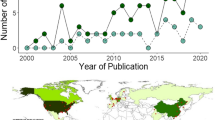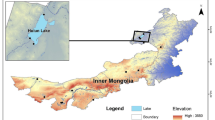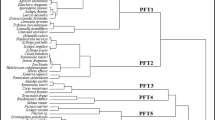Abstract
Floristic quality assessment (FQA) is a commonly used indicator system to evaluate the condition of wetlands. FQA metrics are based on coefficients of conservatism (C-values), numeric values assigned to plant species by expert botanists. C-values reflect a species’ fidelity to high quality natural areas and intolerance to human impacts. Although FQA metrics are widely used in wetland management, few studies have characterized the ecological traits associated with C-values. These few studies have found consistent relationships between functional traits and C-values. Moreover, some research also suggests that conservative species may benefit from arbuscular mycorrhizal fungi (AMF). We conducted a greenhouse experiment to characterize the functional and growth characteristics associated with C-values. We grew 42 species found in midwestern (USA) wetlands and measured nine functional traits of the study species, as well as their responses to AMF addition and nutrient addition treatments. We supplemented the greenhouse experiment with leaf functional trait data from 72 wetland species collected in the field. For the greenhouse experiment, we found weak negative associations between C-values and both height and total biomass, and a positive association between C-values and seed mass. However, in both the greenhouse experiment and the field-collected data, most functional traits did not significantly relate to C-values. AMF addition generally decreased biomass, whereas nutrient addition increased biomass. Response to AMF addition was not significantly related to C-values. Species with lower C-values were more responsive to nutrient treatments compared to those with higher C-values, though this relationship was due to nonnative species with C-values of 0. Our findings could reflect functional differences between dominant wetland matrix species with low C-values, especially nonnative species, and species that are smaller and more conservative. Our data indicate that C-values may not consistently or strongly correspond to functional traits and treatment responses.


Similar content being viewed by others
Data availability
The data is available at the Illinois Data Bank: https://doi.org/10.13012/B2IDB-6489931_V1.
Code availability
The code to analyze the data are available through request to the first author.
References
Alemu T, Bahrndorff S, Pertoldi C, Hundera K, Alemayehu E, Ambelu A (2018) Development of a plant based riparian index of biotic integrity (RIBI) for assessing the ecological condition of highland streams in East Africa. Ecol Indic 87:77–85. https://doi.org/10.1016/j.ecolind.2017.12.032
Andreas BK, Mack JJ, McCormac JS (2004) Floristic quality Assessment index (FQAI) for vascular plants and mosses for the state of Ohio. Ohio Environmental Protection Agency, Division of Surface Water, Wetland Ecology Group, Columbus
Bart D (2021) Vegetation changes associated with release from cattle grazing in a WI calcareous fen. Wetl Ecol Manag 29:67–79. https://doi.org/10.1007/s11273-020-09767-4
Barton K (2019) Package ‘MuMIn’ V. 1.43.6
Bauer JT, Koziol L, Bever JD (2018) Ecology of Floristic Quality Assessment: testing for correlations between coefficients of conservatism, species traits and mycorrhizal responsiveness. AoB Plants 10:plx073. https://doi.org/10.1093/aobpla/plx073
Boutin C, Keddy PA (1993) A functional classification of wetland plants. J Veg Sci 4:591–600. https://doi.org/10.2307/3236124
Bried JT, Edinger GJ (2009) Baseline floristic assessment and classification of pine barrens vernal pools. J Torrey Bot Soc 136:128–136. https://doi.org/10.3159/08-RA-082R.1
Clark CM, Simkin SM, Allen EB, Bowman WD, Belnap J, Brooks ML et al (2019) Potential vulnerability of 348 herbaceous species to atmospheric deposition of nitrogen and sulfur in the United States. Nat Plants 5:697–705. https://doi.org/10.1038/s41477-019-0442-8
Cohen MJ, Carstenn S, Lane CR (2004) Floristic quality indices for biotic assessment of depressional marsh condition in Florida. Ecol Appl 14:784–794. https://doi.org/10.1890/02-5378
Curtis JT (1959) Prairie. The vegetation of Wisconsin: an ordination of plant communities. University of Wisconsin Press, Madison, WI, pp 261–307
David MB, Gentry LE, Kovacic DA, Smith KM (1997) Nitrogen balance in and export from an agricultural watershed. J Environ Qual 26:1038–1048. https://doi.org/10.2134/jeq1997.00472425002600040015x
DeBerry DA, Chamberlain SJ, Matthews JW (2015) Trends in Floristic Quality Assessment for wetland evaluation. Wetl Sci Pract 32:12–22
Díaz S, Kattge J, Cornelissen JHC, Wright IJ, Lavorel S, Dray S et al (2016) The global spectrum of plant form and function. Nature 529:167–171. https://doi.org/10.1038/nature16489
Dunham RM, Ray AM, Inouye RS (2003) Growth, physiology, and chemistry of mycorrhizal and nonmycorrhizal Typha latifolia seedlings. Wetlands 23:890–896. https://doi.org/10.1672/0277-5212(2003)023[0890:GPACOM]2.0.CO;2
Easlon HM, Bloom AJ (2014) Easy Leaf Area: automated digital image analysis for rapid and accurate measurement of leaf area. App Plant Sci 2:1400033. https://doi.org/10.3732/apps.1400033
Erdős L, Bede-Fazekas A, Bátori Z, Berg C, Kröel-Dulay G, Magnes M et al (2022) Species-based indicators to assess habitat degradation: comparing the conceptual, methodological, and ecological relationships between hemeroby and naturalness values. Ecol Indic 136:108707. https://doi.org/10.1016/j.ecolind.2022.108707
Ficken CD, Rooney RC (2020) Linking plant conservatism scores to plant functional traits. Ecol Indic 115:106376. https://doi.org/10.1016/j.ecolind.2020.106376
Fraser LH, Feinstein LM (2005) Effects of mycorrhizal inoculant, N:P supply ration, and water level on the growth and biomass allocation of three wetland plant species. Can J Bot 83:1117–1125. https://doi.org/10.1139/b05-084
Galatowitsch SM, Anderson NO, Ascher PD (1999) Invasiveness in wetland plants in temperate North America. Wetlands 19:733–755. https://doi.org/10.1007/BF03161781
Herben T, Chytrý M, Klimešová J (2016) A quest for species-level indicator values for disturbance. J Veg Sci 27:628–636. https://doi.org/10.1111/jvs.12384
Keddy PA (2010) Wetland ecology, principles and conservation, 2nd edn. Cambridge University Press, Cambridge
Koziol L, Bever JD (2015) Mycorrhizal response trades off with plant growth rate and increases with plant successional status. Ecology 96:1768–1774. https://doi.org/10.1890/14-2208.1
Larkin DJ, Freyman MJ, Lishawa SC, Geddes P, Tuchman NC (2012) Mechanisms of dominance by the invasive hybrid cattail Typha × glauca. Biol Invasions 14:65–77. https://doi.org/10.1007/s10530-011-0059-y
Levin SA, Mooney HA, Field C (1989) The dependence of plant root:shoot ratios on internal nitrogen concentration. Ann Bot 64:71–75. https://doi.org/10.1093/oxfordjournals.aob.a087810
Lopez RD, Fennessy MS (2002) Testing the Floristic Quality Assessment Index as an indicator of wetland condition. Ecol Appl 12:487–497. https://doi.org/10.1890/1051-0761(2002)012[0487:TTFQAI]2.0.CO;2
Lougheed VL, McIntosh MD, Parker CA, Stevenson RJ (2008) Wetland degradation leads to homogenization of the biota at local and landscape scales. Freshw Biol 53:2402–2413. https://doi.org/10.1111/j.1365-2427.2008.02064.x
MacArthur RH, Wilson EO (1967) The theory of island biogeography. Princeton University Press, Princeton, NJ, USA
Matthews JW, Spyreas G, Endress AG (2009) Trajectories of vegetation-based indicators used to assess wetland restoration progress. Ecol Appl 19:2093–2107. https://doi.org/10.1890/08-1371.1
Matthews JW, Spyreas G, Long CM (2015) A null model of Floristic Quality Assessment: are species’ coefficients of conservatism valid? Ecol Indic 52:1–7. https://doi.org/10.1016/j.ecolind.2014.11.017
Nakagawa S, Schielzeth H (2013) A general and simple method for obtaining R2 from generalized linear mixed-effects models. Methods Ecol Evol 4:133–142. https://doi.org/10.1111/j.2041-210x.2012.00261.x
Pérez-Harguindeguy N, Díaz S, Garnier E, Lavorel S, Poorter H, Jaureguiberry P et al (2013) New handbook for standardised measurement of plant functional traits worldwide. Aust J Bot 61:167–234. https://doi.org/10.1071/BT12225
Price EPF, Spyreas G, Matthews JW (2020) Biotic homogenization of wetland vegetation in the conterminous United States driven by Phalaris arundinacea and anthropogenic disturbance. Landsc Ecol 35:779–792. https://doi.org/10.1007/s10980-020-00978-x
Ramírez-Viga TK, Aguilar R, Castillo-Argüero S, Chiappa-Carrara × , Guadarrama P, Ramos-Zapata J (2018) Wetland plant species improve performance when inoculated with arbuscular mycorrhizal fungi: a meta-analysis of experimental pot studies. Mycorrhiza 28:477–493. https://doi.org/10.1007/s00572-018-0839-7
Spyreas G (2019) Floristic Quality Assessment: a critique, a defense, and a primer. Ecosphere 10:e02825. https://doi.org/10.1002/ecs2.2825
Spyreas G, Ellis J, Carroll C, Molano-Flores B (2004) Non-native plant commonness and dominance in the forests, wetlands, and grasslands of Illinois, USA. Nat Areas J 24:290–299
Spyreas G, Meiners SJ, Matthews JW, Molano-Flores B (2012) Successional trends in floristic quality. J Appl Ecol 49:339–348. https://doi.org/10.1111/j.1365-2664.2011.02100.x
Stapanian MA, Schumacher W, Gara B, Monteith SE (2016) Negative effects of excessive soil phosphorus on floristic quality in Ohio wetlands. Sci Total Environ 551–552:556–562. https://doi.org/10.1016/j.scitotenv.2016.02.041
Sudová R, Vosátka M (2008) Effects of inoculation with native arbuscular mycorrhizal fungi on clonal growth of Potentilla reptans and Fragaria moschata (Rosaceae). Plant Soil 308:55–67. https://doi.org/10.1007/s11104-008-9605-5
Suhr D (2005) Principal component analysis vs. exploratory factor analysis. SUGI 30 Proc 203–230
Swink F, Wilhelm G (1979) Plants of the Chicago Region, revised and expanded edition with keys. The Morton Arboretum, Lisle, IL, USA
Taddeo S, Dronova I (2018) Indicators of vegetation development in restored wetlands. Ecol Indic 94:454–467. https://doi.org/10.1016/j.ecolind.2018.07.010
Taft JB, Wilhelm GS, Ladd DM, Masters LA (1997) Floristic Quality Assessment for vegetation in Illinois, a method for assessing vegetation integrity. Erigenia 15:3–95
U.S. Army Corps of Engineers (2018) National Wetland Plant List, version 3.4. http://wetland-plants.usace.army.mil/
USDA, NRCS (2020) The PLANTS Database. National Plant Data Team. http://plants.usda.gov/
Wetzel PR (1996) The role of arbuscular mycorrhizal fungi in prairie wetlands [dissertation, Iowa State University] ProQuest Dissertations Publishing
Woo I, Zedler JB (2002) Can nutrients alone shift a sedge meadow towards dominance by the invasive Typha × glauca? Wetlands 22:509–521. https://doi.org/10.1672/0277-5212(2002)022[0509:CNASAS]2.0.CO;2
Yepsen M, Baldwin AH, Whigham DF, McFarland E, LaForgia M, Lang M (2014) Agricultural wetland restorations on the USA Atlantic Coastal Plain achieve diverse native wetland plant communities but differ from natural wetlands. Agric Ecosyst Environ 197:11–20. https://doi.org/10.1016/j.agee.2014.07.007
Zhang H, Qin Z, Chu Y, Li X, Christie P, Zhang J, Gai J (2019) Interactions between arbuscular mycorrhizal fungi and non-host Carex capillacea. Mycorrhiza 29:149–157. https://doi.org/10.1007/s00572-019-00882-6
Zinnen J, Spyreas G, Erdős L, Berg C, Matthews JW (2021a) Expert-based measures of human impact to vegetation. Appl Veg Sci 24:e12523. https://doi.org/10.1111/avsc.12523
Zinnen J, Spyreas G, Zaya DN, Matthews JW (2021b) Niche ecology in Floristic Quality Assessment: are species with higher conservatism more specialized? Ecol Indic 121:107078. https://doi.org/10.1016/j.ecolind.2020.107078
Acknowledgements
Two anonymous reviewers provided us with valuable feedback on the earlier version of this work. We thank the Plant Care Facilities staff, specifically Clinton Shipley and Rosalie Metallo for labor, materials, and advice. Piper Siblik, Lilliana Romero, and Ken Robertson aided with maintaining and processing greenhouse samples.
Funding
Funding for the greenhouse experiment was provided by a 2019 Student Research Grant to J. Zinnen from the Society of Wetland Scientists. A pilot version of the greenhouse experiment was funded by a grant to J. Zinnen from the Illinois Native Plant Society. Field collection of trait data was supported by a 2020 Midwest-Great Lakes Chapter of the Society for Ecological Restoration Student Restoration Research Grant to B. Charles, and a 2020 Research Grant from the Illinois Native Plant Society. This research was additionally supported by the National Institute of Food and Agriculture, U.S. Department of Agriculture, under Hatch project 1018621.
Author information
Authors and Affiliations
Corresponding author
Ethics declarations
Conflict of interest
The authors declare that they have no conflict of interest.
Additional information
Publisher’s note
Springer Nature remains neutral with regard to jurisdictional claims in published maps and institutional affiliations.
Supplementary Information
Below is the link to the electronic supplementary material.
Rights and permissions
About this article
Cite this article
Zinnen, J., Charles, B., Zaya, D.N. et al. Functional traits and responses to nutrient and mycorrhizal addition are inconsistently related to wetland plant species’ coefficients of conservatism. Wetlands Ecol Manage 30, 513–526 (2022). https://doi.org/10.1007/s11273-022-09877-1
Received:
Accepted:
Published:
Issue Date:
DOI: https://doi.org/10.1007/s11273-022-09877-1




